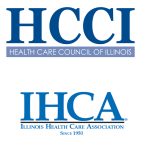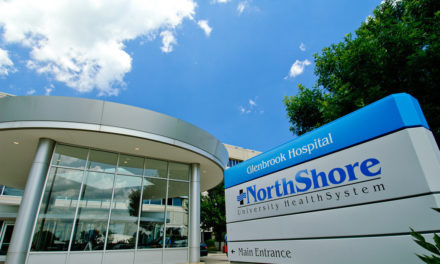
Patti Fischer of HSHS St. Elizabeth’s Hospital talks COVID-19 in the Metro East region

The Metro East became the first region of Illinois to see restrictions reimplemented due to its COVID-19 metrics.
The restrictions, which went into effect Tuesday, will impact bars, restaurants and other businesses. With a growing number of cases in younger residents, the restrictions could help mitigate the spread of the virus in the region, said Patti Fischer, president and CEO of HSHS St. Elizabeth’s Hospital in O’Fallon.
“We all want people to go back to work and try to go back to normal,” she said. “We want the businesses to regain what they’ve lost, but we can’t do that at the risk of infecting and increasing our positivity rates.”
Fischer spoke with Health News Illinois Thursday about the region’s rise in COVID-19, the challenges of mitigating its spread across two states and the importance of educating residents about preventive measures.
Edited excerpts below:
HNI: As of Thursday, what is the situation for COVID-19 in the Metro East region?
PF: We have a 9.5 percent seven-day rolling average of positive cases in our region, and that was as of Wednesday. Tuesday it was at 9.4 percent, so we’ve seen a steady increase for 10 days in a row. And so, due to that, the governor then instituted new restrictions on our area. They really don’t, for the most part or at all, affect the hospitals in terms of how we’re operating and what we’re doing at the current time. The 25 percent or 25 guests in a room, we’ve typically have been observing that anyway. So, other than that, none of the other things really affect us.
HNI: What do you think has been driving this rise in cases and the positivity rate in the region?
PF: When you open up and you have more social interaction, then you have more chances of infection. The unique situation we have down here is that we’re so close to Missouri. And so we have people who live on this side of the river and work in Missouri, and then we have people who live in Missouri and work over here. So just through everyday work, we have people going back-and-forth on a daily basis. And then we also have, from what I have seen, there is increased activity going to Missouri, outside of even the work travel that people normally do as well. Missouri’s rates are higher than Illinois, and they do have fewer restrictions. And we’re definitely seeing younger people who are testing positive. In March, April and May, we had a much older population of people, especially those who were coming to the hospital, from a lot of nursing home and congregate living settings. So we’re not seeing as much of that now.
HNI: Have we seen an uptick in hospitalizations yet? Is there a concern that may increase as the number of cases goes up?
PF: We have seen somewhat of an uptick, but it’s still not where it had been when it peaked. I think it peaked at the end of April and the beginning of May. Like I said, we have a younger population per se who are testing positive, so that’s helpful for the hospitalizations. And we also have the treatment, remdesivir, and that seems to be helping as well. As time has gone by, there has been more information and more science around how to treat patients. So we have seen some improvement in the outcomes of patients as well because of the advancements as we learn more about the disease.
HNI: Gov. JB Pritzker recently reimplemented restrictions in the region to address the rise in COVID. What effect do you think that will have?
PF: I hope they will decrease (the COVID-19 rates). It’s twofold. The increase has been caused by people who have not been social distancing, wearing masks, and people have been congregating at restaurants, bars and other gatherings. If that’s what the causes are, then these restrictions should certainly help. I think it’s also a sign of what will happen If people don’t do what everybody needs to do in terms of wearing masks and social distancing. We all want people to go back to work and try to go back to normal. We want the businesses to regain what they’ve lost, but we can’t do that at the risk of infecting and increasing our positivity rates. So I’m hoping that the restrictions will also make people think twice about their activities and their practices around how they operate on a daily basis.
HNI: What are the ways that health leaders can work together with their Missouri counterparts to address this issue?
PF: Early on, I was on phone calls and in some of the meetings with the healthcare leaders of the big systems, and my sense was that they were doing an excellent job of keeping the local officials informed and really working forward and moving the bar for restrictions. A lot of the things they put in place in St. Louis, the city and the county, have been more restrictive than the state overall. Now I’m not an expert on all that, but I do think from what I’ve seen is that they certainly are putting a great effort into making sure they are a part of the solution.
HNI: How is the testing in the region?
PF: Testing is an issue everywhere across the country, and it is an issue here as well. We are able to do some in-house testing, but we have a limited supply. So we have to be very judicious in who we test. In addition to our in-house testing, we have a contract with Quest lab company. So we do the majority of our testing through them. We do get about a two-day turnaround time, which is better than what you hear about in the media, but it would be much better to have a three-hour turnaround time. That would be much more manageable and would give us better information and give us the ability to act quickly as well. It’s definitely probably, but I’m hopeful with the new saliva testing that’s just been approved, that could really be a game-changer.
HNI: What more can local and state policymakers do?
PF: I think education over the things that we’ve been talking about, encouraging people to wear face coverings, doing social distancing, washing their hands and using hand sanitizer, staying home if you feel sick. The public health departments are actively working with contact tracers as well so that we can make sure we identify people and inform people if they have been exposed so that they can stay home. It has to be a message that it’s good for all of us, and it’s not political to wear a mask. It’s what keeps people safe, it keeps our caregivers safe, police officers and your grandma and grandpa, it keeps them safe as well. There’s more research that comes out, more information that comes out every day. So we’re finding that people who have been infected are developing heart disease and kidney disease now, and people of any age can develop that. So it’s definitely not the same thing as the flu, and it can have potentially devastating ramifications for people after they’ve had it. I think education along those lines and just continued, non-judgmental focus as well would be helpful.
For the latest developments in COVID-19 in Illinois, follow Health News Illinois on Twitter at @healthnewsil or check out our website. For complete healthcare coverage, sign up for a free trial to our daily email newsletter.








